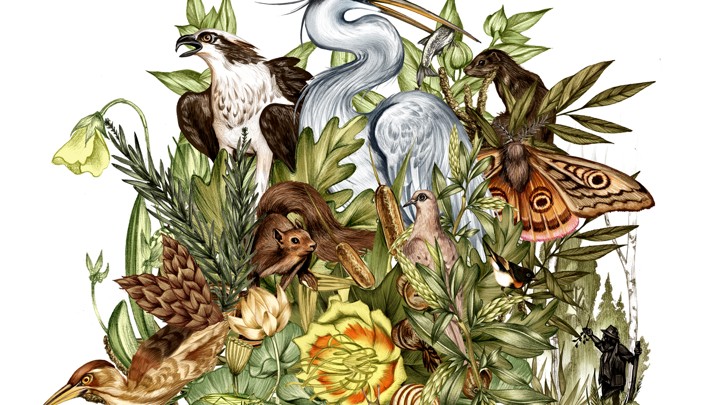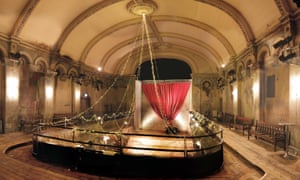via OUP blog by Susan Ratcliffe

“Jefferson, Thomas (bust)” from the National Archives and Records Administration. Public Domain via Wikimedia Commons.
When the Oxford Dictionary of Quotations was first published in 1941, it all seemed so simple. It was taken for granted that a quotation was a familiar line from a great poet or a famous figure in history, and the source could easily be found in standard literary works or history books. Those early compilers of quotations did not think of fake facts and the internet. “Fake facts”, or perhaps more accurately misunderstandings, have been around in the world of quotations for a long time. Often, when people see a line they like, they simply copy it and repeat it.
Continue reading
==============================
In his 2-million-word journal, the transcendentalist discovered how to balance poetic wonder and scientific rigor as he explored the natural world.
via Arts & Letters Daily: Andrea Wulf in The Atlantic

LISEL JANE ASHLOCK
In late 1849, two years after Henry David Thoreau left Walden Pond—where he had lived for two years, two months, and two days in a cabin that he had built himself—he began the process of completely reorienting his life again. His hermit-style interlude at the pond had attracted quite a bit of attention in his hometown of Concord, Massachusetts. “Living alone on the pond in ostentatious simplicity, right in sight of a main road,” his latest biographer, Laura Dassow Walls, writes, “he became a spectacle,” admired by some and belittled by others. Thoreau’s subsequent life change was less conspicuous. Yet it engaged him in a quest more enlightening and relevant today than the proud asceticism he flaunted throughout Walden, a book that has never ceased to inspire reverence or provoke contempt.
==============================
via Boing Boing by Cory Doctorow

Jonathan Simmonds, an MD in Boston, MA, created these Map Anatomy illustrations that represent a detailed, functional diagram of the human head's anatomy in the style of a London tubemap; you can buy downloads and posters from his Etsy store, but act quickly, because Transport for London are notorious, humourless assholes about this kind of thing! (via Reddit)
Checked, still there as at 9.9.18
==============================
via The National Archives Blog by Euan Roger

Geoffrey Chaucer as depicted in the Ellesmere Canterbury Tales (source: Wikicommons)
When you think of Geoffrey Chaucer, what words or themes do you think of? Words like ‘writer’, ‘poet’ and ‘philosopher’ come naturally to mind, but what about ‘accountant’, ‘soldier’, ‘politician’ and ‘debtor’?
Those involved in studying Chaucer have long been aware of his extensive career as a courtier, diplomat and civil servant, but the details and extent of his day job haven’t always permeated the public conscience.
While we don’t hold any of Chaucer’s literary works in our collection, we do have hundreds of documents about the man himself and his activities, which allow us to build up a picture of his life and career through the various offices of state that formed the medieval civil service.
Continue reading
==============================
via the New Statesman by John Gray

PHOTO: CHARLIE SHOEMAKER/GETTY
In a pervasive modern view, which seems to most people so obviously true that they can think in no other way, the past is a burden that must be shed in order that a new kind of life can come into being. Modern human beings are always in transit to another place, which seems only more distant the longer they have been travelling.
Continue reading
==============================
via the Guardian by Maev Kennedy

Wilton’s Music Hall survived the blitz, but came closest to destruction in wholesale demolition and redevelopment of the district in the 1960s Photograph: V&A
An archive recording the glory days as well as the decay and near collapse of Wilton’s Music Hall has been acquired by the V&A theatre collection.
The archive includes a tattered and yellowed campaign poster, showing a shattered window in a mouldering brick wall, a reminder of the half century of attempts to save the rotting building, which claims to be the world’s oldest Victorian music hall. The poster will need expensive conservation work before it can be preserved as a precious relic.
Archivist Sabrina Offord said: “Normally we wouldn’t even try to save a piece of paper in this state, but its state after being moved from noticeboard to noticeboard over the years is part of the story.”
Continue reading
==============================
via OUP blog by Vivian Yan

“Cymbals”. Photo by Nikon Jazz. via Flickr
There are many cymbal variants and a multitude of sounds can be produced depending upon how the instrument is played. With its indefinite pitch and ability to make unusual or striking sounds, cymbals are an integral part of the percussion family.
Continue reading
==============================
via Interesting Literature
A commentary on one of Hopkins’s ‘Terrible Sonnets’
‘No Worst, There Is None’ is one of a group of sonnets the poet Gerard Manley Hopkins (1844-89) wrote when he was suffering from depression in the 1880s, while living in Ireland. These are known as the ‘Terrible Sonnets’ because of the terrible fits of misery and despair which inspired them, and which they so brilliantly capture.
Continue reading
==============================
via the Big Think blog by Robby Berman

(REICH, ET AL.)
At the dawn of the 19th century, when Paolo Mascagni hired Clementi Susini to help him make wax models of the human lymphatic system including the brain, he probably had no idea he was setting himself up for centuries of ridicule. In a 2003 piece about 18th-century science in The Lancet, his “mistake” was condescendingly explained: “Mascagni was probably so impressed with the lymphatic system that he saw lymph vessels even where they did not exist — in the brain.” That sentiment reflects what scientists have long believed. And then lymphatic vessels were found in the dura mater, the membrane covering the brain, of mice by a team from University of Virginia in 2015. The researchers noted, “The discovery of the central-nervous-system lymphatic system may call for a reassessment of basic assumptions in neuroimmunology.” Ah, sweet vindication, 300 years later.
Continue reading
==============================
via Boing Boing by Sarina Frauenfelder

Pedro Friedeberg is a popular Mexican artist whose work encompasses the ideas and iconographies of Catholicism, Hinduism, Aztec Codes, and Occult symbols. Although the Hand Chair (shown below), created in 1962, is his most well-known piece, the 81-year-old artist has a diverse body of work that spans six decades and that includes furniture, paintings, drawings, and sculpture.
Continue reading
No comments:
Post a Comment